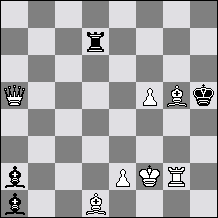|
A Bottachi
L`Italia Scacchistica, 1919
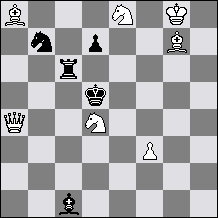
#2 7 + 5
|
G F Anderson
Il Secolo, 1919
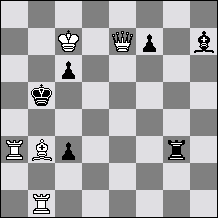
#2
5 + 6
|
A C White
1st Prize Good Companion, 1918
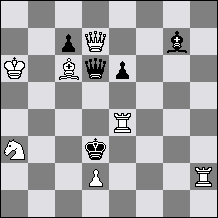
#2
7 + 5
|
|
H V Tuxen
1st Prize Good Companion, 1919
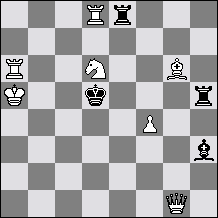
#2
7 + 4 |
C Monsfield
1st prize Falkirk Herald Meredith Tourney, 1927
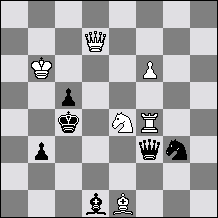
#2
6 + 6 |
E Umnov
Shakhmaty v SSSR, 1945
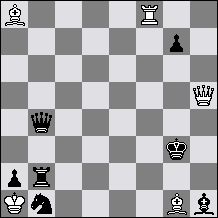
#2
5 + 7
|
|
C Promislo
3rd Honorable Mention, 8th American Chess Congress, 1921
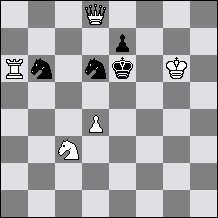
#2
5 + 4 |
H D`o Bernard
Chess Amateur 1919
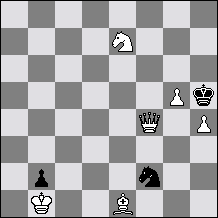
#2
6 + 3 |
J Hartong
Probleemblad, 1951
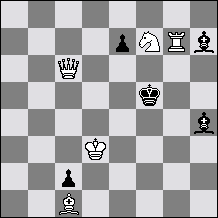
#2
5 + 5
|
|
V. Bartolovic
2nd HM Problemnoter 1954-55
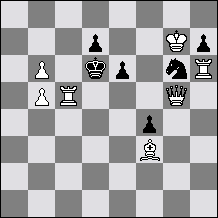
#2
7 + 6 |
Z Zilahi
2nd Prize L`Echiquier de Paris 1948
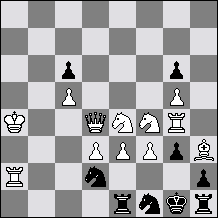
#2
12 + 9 |
Israel Han
1st Prize
Israeli Problemists Association Buletin 1947-48

#2
( 9 + 7 ) |
|
A Bottachi
L`Italia Scacchistica, 1919

#2 7 + 5
|
1.Se6! (2.Qe4#)
1...Rc4 2.Qxd7#
1...Rxe6 2.Qb5#
1...Sc5 2.S6c7#
1...Sd6 2.S8c7#
The problem show a combination of "half-pin" and "self-blocks". The
black rook and knight are form the half-pin: when the rook moves the
knight is pinned and when the knight moves the rook is pinned. It is
important that the actual mates take advantage of the pins, as is the
case in this problem. The self-blocks are the blocking by a black piece
of a square adjacent to the black king and blocking a flight. For
example, the defense 1...Rc4 blocks the square c4 so the Queen no longer
has to guard it and cane mate by 2.Qxd7#
In this problem all four moves by the half-pinned pieces are also
self-blocks.
All these is achieved with only 12 pieces - a "Meredith" (problems with
8 to 12 pieces; problems with 7 or less pieces are "Miniatures").
|
|
G F Anderson
Il Secolo, 1919

#2
5 + 6
|
1.Kd6!! (2.Qb7#)
1...Rd3+ 2.Bd5#
1...Rg6+ 2.Be6#
1...Kb6 2.Bc2#
1...Kb4 2.Kxc6#
A surprising key move granting two flights and allowing to checks.
The main idea are the "cross-checks" by the black rook. Note how the
rook performs interferences of the black bishop, enabling the battery
mates by the white bishop.
Further battery play follows the moves of the black king to the flights,
with a "royal battery" mate after 1...Kb4
|
|
A C White
1st Prize Good Companion, 1918

#2
7 + 5
|
1.Rb4! zz
(zugzwang)
1...Qxd7 2.Bd4#
1...Qd5 2.Bb5#
1...Qd4 2.Rb3#
1...B~ 2.Qh7#
1...e5 2.Rb3#
The first two moves by the black queen perform "withdrawal unpins of the
white bishop. Note how the two mates by the bishop are nicely
differentiated. The move 1...Qd4 is an interference (of the black
bishop) by a pinned piece.
In a zugzwang problem there is no threat, and there is a mate on any
black move.
|
|
H V Tuxen
1st Prize Good Companion, 1919

#2
7 + 4 |
1.Qc1! (2.Qc4#)
1...Ke6+ 2.Sf5#
1...Kd4+ 2.Sb5#
1...Bf1 2.Sxe8#
1...Re4 2.Sf5#
The key grant a flight in addition to the one existing in the set (the
diagram position). In both cases, the moves by the black king are checks
answered by battery mates by the knight. Checks answered by checks are
"cross checks" and this is the main idea of the problem. Two more
battery mates are given after two other defenses.
|
|
C Monsfield
1st prize Falkirk Herald Meredith Tourney, 1927

#2
6 + 6 |
1.Kc6! (2.Qd5#)
1...Qd3 2.Sd6# (Sd2?)
1...Qc3 2.Sd2# (Sd6?)
1...Qh5 2.Sxg3#
The defenses by the black queen to d3 and c3 unpin the white knight
allowing double-check mates. However, only one of the mates is possible,
taking advantage of the self-blocks. Note that the key actually pins the
white knight. Since the unpins of the knight is the central idea of the
problem the key is "thematic".
|
|
E Umnov
Shakhmaty v SSSR, 1945

#2
5 + 7
|
1.Bg2! (2.Qh3#)
1...Rxg2 2.Rf3#
1...Bxg2 2.Bh2#
1...Qh4 2.Qf3#
1...Qg4 2.Qh2#
The key moves to the intersection square of the black rook and bishop.
Such a move performs the "Novotny" theme. However, the mates 2.Rf3 and
2.Bh2 are not possible since square g2 is not guarded. Only after the
captures on g2, and self-blocks on this square, these mates become
possible. Two further self-block by the black queen enable mate by the
white queen on those same squares, f3 and h2, taking advantage of the
interferences by the key move.
|
|
C Promislo
3rd Honorable Mention, 8th American Chess Congress, 1921

#2
5 + 4 |
set:
1...Sb~ 2.Qc8#
1...Sd7 2.Qg8#
1...Sd~ 2.Qd5#
Solution:
1.Qc7! zz (white to play)
1...Sb~ 2.Qc8#
1...Sd7 2.Qc4#
1...Sd~ 2.d5#
In the set there are mates ready for all black moves. Thus, any waiting
white move can solve...but there is no such move! The solution causes a
change of the mates following the moves 1...Sd7 and 1...Sd~, the colors
emphasize the changing of the mates. This is a "mutate", and we have two
changed mates.
|
|
H D`o Bernard
Chess Amateur 1919

#2
6 + 3 |
Set:
1...S~ 2.Qf3#
1...Sg4 2.Qf7#
Try:
1.Qc4? zz
1...S~ 2.Qe2#
1...Sg4 2.Qf7#
but 1...Sd3!
Solution:
1.Qa4! zz (white to play)
1...S~ 2.Qd1#
1...Sg4 2.Qe8#
Again, everything is ready in the diagram position but white have no
waiting move. The solution changes the two set mates. The moves by the
black knight form "black correction": a random move leads to a certain
mate so the knight performs a correction by moving to g4 and preventing
that mate. However, the correction is a self-block on g4 enabling
another mate.
The try 1.Qc4? should not be missed, it changes one of the mates but
fails by another "correction" move by the black knight.
|
|
J Hartong
Probleemblad, 1951

#2
5 + 5 |
Set:
1...e6 2.Qf3#
1...e5 2.Sh6#
1...Bf6 2.Qe4#
Solution:
1.Qh6! zz (white to play)
1...e6 2.Qf4#
1...e5 2.Sd6#
1...Bf6 2.Qh3#
(1...B7~,B4~ 2.Qg6,Rg5#)
In this mutate we have three changed mates, all of them after
self-blocks. And what else? Yes, black correction by bishop h4.
|
|
V. Bartolovic
2nd HM Problemnoter 1954-55

#2
7 + 6 |
Set:
1...S~ a 2.Rd5 A #
1...e5 b 2.Qxe5 B #
Solution:
1.Kf6! zz (white to play)
1...S~ a 2.Qe5 B #
1...e5 b 2.Rd5 A #
Here we have a special case of mate changes. The mates are actually
exchanged - this is termed "reciprocal changes". In the set we have a
half-pin which is broken up by the key. Note how the fact that there is
no longer a half-pin and that the square e7 is guarded causes the
exchange of the mate. This is the mechanism of the reciprocal changes.
|
|
Z Zilahi
2nd Prize L`Echiquier de Paris 1948

#2
12 + 9 |
Set:
1...Rxe3 a 2.Se2 A #
1...Sxe3 b 2.Rxg3 B #
Solution:
1.Qa1! zz (white to play)
1...Rxe3 a 2.Rxg3 B #
1...Sxe3 b 2.Se2 A #
A very different mechanism of reciprocal changes is shown here. In the
set the captures on e3 lead to self-pins on e3. However, the key
abandons this pin-line and instead we have a half-pin. Now, the capture
on e3 lead to pins of the other black piece! Note how the move 1...Rxe3
is actually a correction move!
|
Israel Han
1st Prize
Israeli Problemists Association Buletin 1947-48

#2
( 9 + 7 ) |
Set:
1...Rxc6 a 2.Re6 A #
1...Sxc6 b 2.Sc5 B #
Solution: 1.Qb7! (2.Rxc4#)
1...Rxc6 a 2.Sc5 B #
1...Sxc6 b 2.Re6 A #
The problem has the same reciprocal changes mechanism as the previous
one, but here the idea is presented as "free changed mates". There are
many black moves for which no mates are ready in the set, so why focus
on the specific ones? The comparison with the previous problem gives the
answer: because these are interesting moves! They are interesting also
because we know from the solution that these moves are at the heart of
the problem, so it is interesting to see what happens in the set.
|
